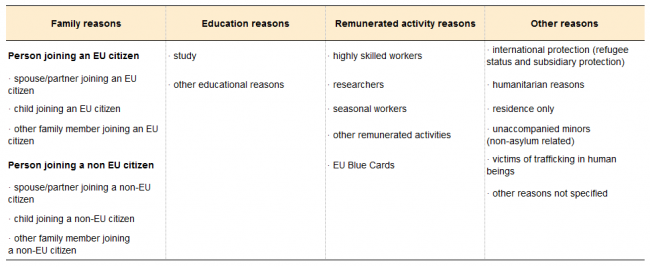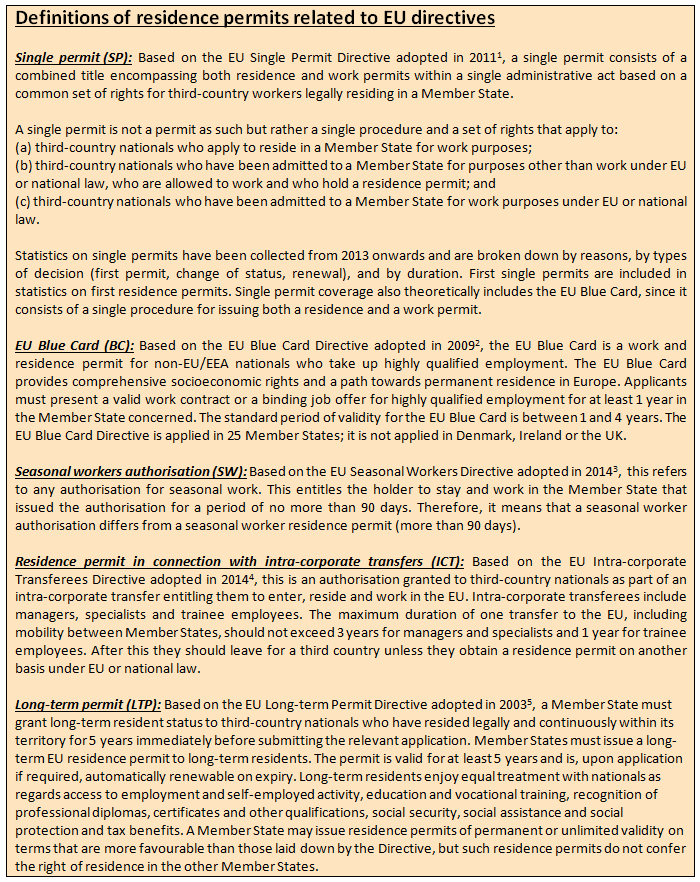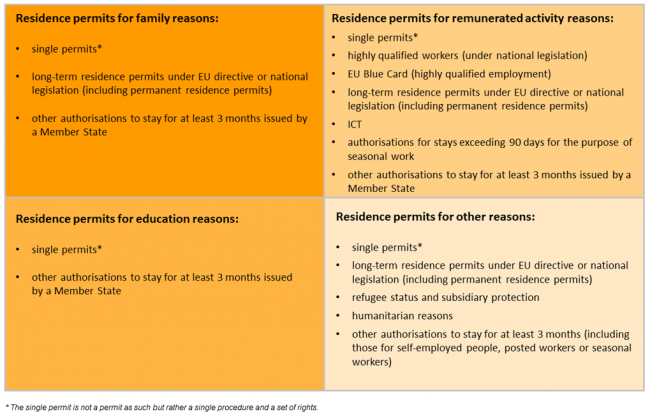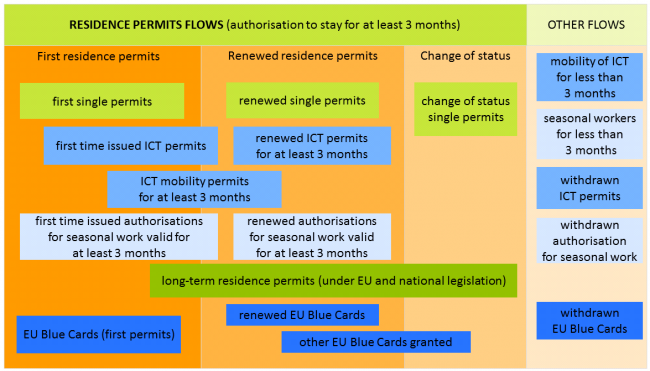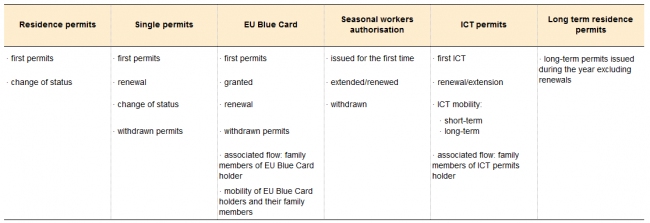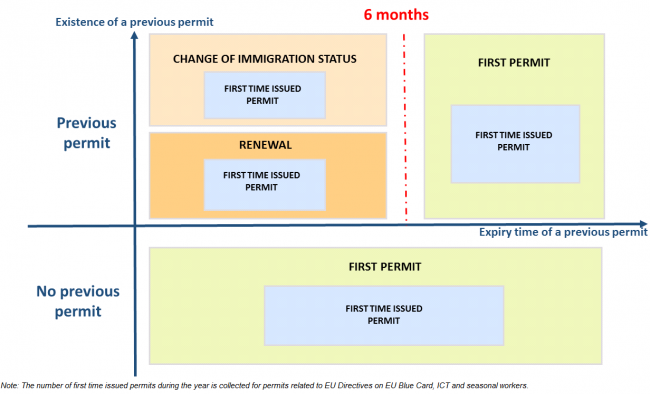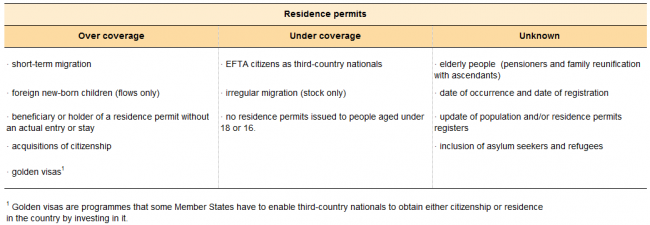Data extracted in July 2018
The aim of this article is to provide an overview of the methodological and analytical framework used for the residence permits statistics collected by Eurostat. Methodological concepts, classifications and definitions as well as the scope and purposes of those statistics are presented, with particular attention paid to the links with the related EU Directives adopted in the field of asylum and managed migration.
Main points
- Statistics on residence permits present various types of information on the number and characteristics of third-country nationals (non-EU citizens) [1] authorised to stay in EU and EFTA countries.
- Statistics are mainly derived from administrative sources and registers on the issuing of residence permits.
- A significant part of the statistics covers residence permits issued under EU directives in the field of asylum and managed migration, in particular those defining the access to work and the guarantee of a common set of rights for third-country nationals.
- The field of statistics on residence permits is a specific and evolving area whose methodology is used either for analytical purposes or for comparison with other statistics related to migration.
General presentation and definition
Within the field of Asylum and managed migration statistics [2], statistics collected by Eurostat on residence permits cover all the authorisations valid for at least 3 months issued by a Member State’s authorities allowing a third-country national to stay legally on its territory. When the national laws and administrative practices of a Member State allow for specific types of long-term visa or immigration status to be granted instead of residence permits, they are also included in residence permit statistics.
Data are entirely based on administrative sources, apart from in the United Kingdom [3] and are provided mainly by interior ministries or related immigration agencies. Eurostat statistics on residence permits are collected on the basis of Article 6 of Council Regulation (EC) No 862/2007. The first reference year for the data collection on residence permits was 2008 and statistics are generally disseminated in June and July in the year following the reference year.
Eurostat collects statistics on flows and stocks that are broken down by reasons for migration, by duration of the residence permit issued, by citizenship, by age, by sex, and by occupation for residence permits issued for work (see Table 1 and Table 2). The statistical unit for all the collected statistics refers to the number of people (third-country nationals/non-EU citizens), not to the number of administrative decisions or acts.
First permit is the main category of flow data on residence permits, since it aims to measure the number of third-country nationals who received for the first time within the last 6 months an authorisation to enter and stay for at least 3 months within the EU’s territory. Eurostat also collects other flow data on residence permits concerning categories such as change of status, renewal, withdrawn permits, and granted permits[4]. These flow data provide some complementary information (a more detailed description of available flows is presented in the next section).
Reported stocks of residence permits correspond to the number of residence permits that are valid at the end of the year.
The detailed classification of the disaggregation by reasons for issuing residence permits is presented in Table 1, whereas Table 2 shows other available classifications used for breaking down residence permit statistics.
Regarding the available breakdowns shown below, the reason for migration is more specific to the collection of data on residence permits and indicates the main reason why a residence permit has been granted. Classification by reason for issuing residence permits consists of four main categories: family reasons, education reasons, remunerated activity reasons and other reasons.
In addition to this general data collection on residence permits, since 2008 Eurostat has developed new forms of data collection to obtain additional statistical information focusing on some specific types of residence permits directly connected with EU directives in the field of the EU asylum and managed migration policy:
- EU Blue Card (first reference year: 2012);
- single permit (first reference year: 2013);
- seasonal workers (first reference year: 2017),
- intra-corporate transfers (first reference year: 2017);
- long-term permits (first reference year: 2008 for the stocks and 2016 for the flows).
Detailed definitions and descriptions related to those permits are provided in the text box below.
In term of geographical coverage, the EU-28 Member States and EFTA countries are reporting statistics on residence permits, whereas for statistics related to EU Directives (BC, SW, SP, ICT and LTP) only 25 Member States report data as Denmark, Ireland and the United Kingdom are not bound by these Directives and are not subject to their application. Depending on the national legislations, some additional data are collected that could overlap with a field covered by an EU directive, such as those on highly qualified workers or long-term residence permits, for which data are collected both under EU directives and under national schemes.
Table 3 provides an overview of the categories of third-country nationals covered by EU directives in the field of legal migration. The scope of the table also covers some other EU directives on family and students and researchers for which specific statistics have not yet been collected. Separate data collection on students’ and researchers’ permits will start in 2020 with 2019 as the first reference year for data. This future data collection will cover third-country nationals who apply to be admitted or who have been admitted to a Member State for the purpose of research, studying, training or volunteering in the European Voluntary Service. Member States may also decide to include data on third-country nationals who apply to be admitted as part of a pupil exchange scheme or educational project, to undertake voluntary service other than with the European Voluntary Service or to work as an au pair.
The statistical information on third-country nationals granted a residence permit under the umbrella of an EU directive aims to provide additional insights related to the implementation of the EU asylum and managed migration policy. This relates in particular to third-country nationals’ access to the EU labour market and the guarantee of a set of rights, in order to develop the attractiveness of the EU for highly qualified third-country nationals and to simplify administrative procedures for third-country nationals entering or residing in the EU.
From a statistical point of view, data collected under the EU directive umbrella are based on a common and agreed set of definitions and concepts which theoretically guarantee a high level of comparability between the types of permit granted by the Member States. However, this comparability depends on the extent to which Member States have transposed the EU directives and on whether more favourable national schemes exist (i.e. set of rights granted to third-country nationals) other than the one defined in the EU directives.
Therefore, statistics on residence permits have a twofold objective described as follows.
- To measure the flows and the stocks related to the residence permits that have been issued to third-country nationals in EU and EFTA countries, which gives an insight based upon administrative sources on legal migration that takes place within the EU and EFTA. The breakdown by reasons provides an insight into the main factor that has justified the admission of the migrants (family, education, work or other reasons). Other available breakdowns (age, citizenship, duration and occupation) enable some more targeted analysis to be carried out or the profile of third-country nationals in the EU to be described.
- To measure the flows and the stocks related to the residence permits issued under the umbrella of EU directives in order to analyse EU policies in the field of asylum and managed migration. Most of the collected information focuses on third-country nationals’ access to the EU labour market (single permit, ICT and seasonal workers) and its attractiveness for highly qualified workers (EU Blue Card). Data on single permits and long-term permits measure the development of the use of those instruments used to simplify administrative procedures and set rights for third-country nationals.
Furthermore, Figure 1 below presents a classification of residence permits by types of permit and by reasons for which Eurostat collects statistics.
Available statistics on residence permits issued during the year
First residence permit
Statistics on residence permits issued during the year correspond to flow data. The main flow data are the number of first residence permits issued during the year. A first residence permit is valid for at least 3 months and issued to a third-country national who is entering an EU country for the first time or if there are at least 6 months between the expiry of the old permit and the start of the new one, irrespective of the year when the permit was issued. The statistical definition of first permits relates to permits issued at all levels in administrative/judicial instances and by all national authorities. Therefore, if at the first instance permission to reside is not granted but an appeal decision is positive at the second instance, the permission (resulting from the appeal decision) must be considered as a first permit.
In addition to the total number of first residence permits issued during the year, Eurostat also makes available first permit statistics for the single permit and the EU Blue Card. Concerning ICT and seasonal workers’ permits, the available statistics refer to the permits issued for the first time, meaning that they can differ from the concept of a first residence permit as described above if the ICT transferee or the seasonal worker already had another type of valid residence permit during the previous 6 months in the country. For example, an ICT permit for a trainee employee is granted for the first time in March 2018 under the terms of the ICT Directive to a third-country national who previously held a residence permit for study reasons that was still valid at the end of 2017: this ICT permit will be counted as an ICT permit issued for the first time but not as a first permit since the ICT permit was issued less than 6 months after the end of the previous permit’s validity. If the duration of this ICT permit was at least 3 months, it would be counted as a change of status. Also, taking into account that ICT and seasonal workers permits may be valid for less than 3 months, only permits that are issued for the first time to ICT and seasonal workers that are valid for at least 3 months are considered as a residence permit from a statistical point of view.
Furthermore, as administrative events related to first residence permits are recorded at Member State level, the same person can theoretically receive several first residence permits from different Member States over a given reference period. Therefore, it implies that possible double counting can occur when aggregating Member States’ data at EU level.
Other flow data
Besides first residence permits, Eurostat also collects some other flow data. Change of immigration status during the year corresponds to a residence permit granted during the reference period whenever a third-country national changes their immigration status or their reason to stay in an EU Member State. Permission to reside is considered as a change of immigration status or reason to stay if there are less than 6 months between the expiry of the old permit and the start of the new one and the immigration status or reason to stay has been changed.
Only changes between major categories can be recorded as a change of status. These four major categories (as introduced in Section 1) are: family reasons, education and study, remunerated activities and other reasons. For instance, a change from ‘study reasons’ to ‘other educational-related reasons’ is not a change of immigration status as, in both cases, the residence permit was issued for the same main reason: education. On the other hand, if a student holding a residence permit for educational reasons received a residence permit for a ‘remunerated activity reason’ less than 6 months after the previous permit expired, the new permit would be counted as a change of immigration status in the statistics.
As for the first residence permits, statistics related to the change of immigration status/reason to stay include permissions granted at all levels in administrative/judicial instances and by all national authorities. Data on change of immigration status is collected for all authorisations to stay (residence permits) and also for single permits.
Other available flow data are related to more specific types of residence permits (single permit, EU Blue Card, ICT and seasonal workers). Those flows regard renewals (SP, BC, SW, and ICT), withdrawals (SP, BC, SW and ICT), permits granted (BC and long-term permit) and mobility flows between two Member States for ICT permits. Figure 2 shows the data available by type of permits.
The category ‘renewed residence permits’ consists of the number of residence permits that have been issued within 6 months of the expiry of the previous residence permit and without change of immigration status. Renewed residence permits are collected only for SP, BC, ICT and SW permits. In the case of ICT, ‘Renewed’ refers to ICT permits issued to the same person which are valid immediately after the previous ICT permit expires.
Withdrawn residence permits refer to situations in which issued or renewed residence permits were withdrawn under criteria defined in EU directives. Statistics on ‘withdrawn permits’ are available for SP, BC, ICT and SW.
Granted EU Blue Cards means all EU Blue Cards issued for the first time (regardless of whether the person already had a residence permit issued by the same Member State) and EU Blue Cards issued after the six-month period following the expiry of the previous EU Blue Card (both issued by the same Member State). This implies that some of the EU Blue Cards granted would be considered in the data collected on residence permits as a change of status or a renewal which explains the difference between the number of granted EU Blue Cards and those recorded in first permit statistics[5]. Also concerning EU Blue Card statistics, flows related to the admission of family members of EU Blue Card holders are presented separately, whereas information on the intra-EU mobility of EU Blue Card holders and their family members is also available.
Long-term residence permits (LTR) issued during the year, for which data have been collected since 2016 — the reference year, consist of the number of these permits that are valid for at least 5 years, excluding renewals (i.e. the prolongation of an EU or national LTR permit). The cases where a long-term residence status is granted following a change of category should be included in the LTR permits issued (including the change of permit from a national long-term residence permit to EU long-term residence permit).
The final type of flow available relates to the mobility of intra-corporate transferees. It concerns an intra-EU mobility permit whereby the holder of a valid intra-corporate transferee permit issued by a Member State may enter, stay and work in one or more Member States. Two types of mobility permit exist:
- short-term mobility for the purpose of this Directive covers stays in Member States other than the one that issued the intra-corporate transferee permit, for a period of up to 90 days per Member State;
- long-term mobility for the purpose of this Directive covers stays in Member States other than the one that issued the intra-corporate transferee permit for more than 90 days per Member State.
Methodological issues
As presented in Table 4, the availability of various types of flow data on residence permits differs between the various types of residence permits. The main topics dealt with in the following paragraphs are (i) overlap in coverage between the various flows available; (ii) issues related to possible double counting; (iii) possible confusion between some apparently similar concepts used for classifying flows; and (iv) consistency rules.
Data on flows not included in the total number of residence permits
As already stated, residence permits include all the authorisations to reside that are valid for at least 3 months. Therefore, all types of permits previously mentioned are included in the total number of residence permits if they are valid for at least 3 months. Applying this rule specifically means that authorisations for seasonal work not valid for at least 3 months or short-term ICT mobility permits are not be counted in the total for residence permits. The same applies for renewal/extension of those permits.
First permits and other first time issued permits
The concept of ‘first permit’ applies to residence permits and single permits. However, it differs from the concept of ‘first time issued’ or ‘granted permit’, used for EU Blue Cards, seasonal workers authorisation, ICT permits and long-term residence permits. Figure 3 below illustrates how the classification of flows depends on both the existence and the expiry time of the previous permit. This classification rule applies at the individual Member State level, meaning that possible residence permits issued in other Member States are not taken into consideration when applying the rule.
EU Blue Cards that are granted throughout the year correspond to the total number of BCs issued, except for BC renewals, which, therefore, includes BCs delivered to non-EU citizens who previously held another type of residence permit. In this case it is not considered as a first permit which explains why the total number of first permits for the EU Blue Card differs from the total number of granted BCs collected separately in the specific EU Blue Card section.
First time authorisations for seasonal work, valid for at least 3 months, do not equal the total number of first residence permits recorded in the category for first residence permits for seasonal workers. This is because the concept of ‘first time issued’ differs from that of ‘first residence permits’ as the criteria of having 6 months between the expiry of the previous permit and the beginning of the new one does not apply. It is expected that the number of seasonal workers recorded in first residence permits will be lower than the number of first time authorisations issued for seasonal work valid for at least 3 months; this number will be recorded under the EU Seasonal Workers Directive.
ICT permits issued for the first time are those given to third-country nationals when they are admitted into a Member State under the terms of the ICT Directive. Only ICT permits valid for more than 3 months are included in the total number of first permits. However, the criteria of having 6 months between the expiry of the previous permit and the beginning of the new one also does not apply in this context.
The number of ‘long-term residence permits issued during the year’ refers to those that are valid for at least 5 years, excluding renewals of such permits (the prolongation of an EU or national long-term permit). In most cases, long-term residence permits are granted to third-country nationals who previously held a residence permit valid for less than 5 years, which means that the majority of long-term permits issued during the year should not be included in the first residence permit category.
The cases where long-term residence status is granted following a change of category should be included in the category for long-term residence permits issued (including the change of permit from national long-term residence to EU long-term residence permit).
Single permits
As a single permit consists of a combined title encompassing both residence and work permits within a single administrative act, statistics on single permits should include EU Blue Card permits and ICT permits. For Member States that fully apply the Single Permit Directive, the statistics provided for single permits issued for remunerated activities covered by the Directive theoretically covers all residence permits issued for remunerated activities excluding seasonal workers and some other remunerated activities (self-employed, remunerated trainees, posted workers, seafarers on board a ship registered in or sailing under the flag of a Member State)[6]. Lastly, Member States may decide that the EU Single Permit Directive does not apply to third-country nationals who have been either authorised to work in a Member State for a period not exceeding 6 months or who have been admitted to a Member State for studying purposes.
Coverage and comparability of data among Member States
Some issues on the coverage of the target population or possible double counting could hamper the comparability of statistics on residence permits. Therefore, reference to national metadata[7] is needed when analysing data. For example, some Member States like France and Ireland do not systematically issue residence permits to people aged below 18 and 16 respectively, which implies under-coverage.
As a result of the adopted methodology used for statistics on authorisations for seasonal work, double counting may take place as the same person could be recorded several times during a given reference year.
In several Member States, the distinction between a third-country national joining an EU citizen and one joining a non-EU citizen is either not feasible or only partially feasible. In addition, the breakdown by family member of the residence permits issued for family reasons can differ from the recommended methodology. For example in Latvia, in cases of family reunification with non-Latvian citizens, all family members are included into the category ‘Spouse/Partner’ which means that children who are minors and other family members are included into that category and are thus not broken down into their respective categories (i.e. 'Children' and 'Other family members').
The coverage of, and concepts used, for defining highly qualified workers may differ depending on the residence permit; whether it is issued under a national scheme, the EU Blue Cards Directive or the ICT Directive (for a manager or specialist position). For residence permits in general, highly qualified employment means the employment of someone who, in the Member State concerned, (i) is protected as an employee under national employment law and/or according to national practice, (ii) is paid, and (iii) has sufficient and specific competence required, as proven by higher professional qualifications or other relevant criteria. If there is no specific national scheme in a Member State, there will be no Eurostat data for highly skilled workers, even if that country actually admits highly skilled third-country workers. In this case, data on highly skilled workers will be hidden among that on other remunerated activities permits which leads to possible under-coverage for this category.
Furthermore, differences on how various national schemes are defined at both national level and EU level may also raise comparability issues among Member States concerning the set of rights actually granted to third-country nationals for the same type of permit.
Consistency rules
From the methodological description presented above certain consistency rules can be derived for data on residence permits:
- the number of first single permits are to be lower than the number of first residence permits;
- the number of first single permits issued for remunerated activities reasons are to be equal to or lower than the number of first residence permits issued for remunerated activities.
Available stock data on residence permits
Total number of residence permits at the end of the year
Stock data on residence permits includes all residence permits valid for at least 3 months held by third-country nationals at the end of a reference year (31 December). The length of the validity of the permit refers to the total duration of the valid permit at the date of issuance. For example, if a 12-month permit was issued on 1 July 2017, on the reporting date on 31 December 2017 this permit will be recorded as one that is valid for at least 12 months.
Stock data on residence permits are broken down by reasons, duration, age, sex and citizenship. The list of reasons available contains the following: ‘family reasons’, ‘education reasons’, ‘remunerated activities reasons’, ‘refugee status’, ‘subsidiary protection’ and ‘other reasons’. The coverage of the category ‘other reasons’ can vary across Member States depending on national administrative practices. It can include categories such as: permanent residents — who might be working or not; non-active people (e.g. pensioners, children not yet in education); and people granted national protection status and/or a variety of other national statuses. It may also include valid permits held by third-country nationals who originally came for work or family reasons but for which the national administrations can no longer identify the reason for issuing the original permit. Furthermore, it may also include permits held by citizens from Iceland, Norway, Liechtenstein and Switzerland as these ‘third-country’ citizens have almost the same rights as those of EU citizens.
Long-term permits stock data
The number of ‘long-term residence permits valid at the end of the year’ represents a subset of the dataset on residence permits valid at the end of the year.
Therefore, stock data on long-term residence permits cover all residence permits granted to third-country nationals valid at the end of the year with a duration of at least 5 years (including permanent residence permits). On the one hand the stock data cover residence permits issued under the EU Long-term Permit Directive (note that Denmark, Ireland, the United Kingdom and EFTA countries are not bound by this Directive) and on the other national long-term residence permits issued under national legislation.
In this context, two distinct categories of stock statistics on long-term residence permits are available.
- EU long-term residence permits which are issued under the EU Long-term Permit Directive. These are valid for at least 5 years and are, upon application if required, automatically renewable on expiry. Long-term residents enjoy equal treatment with nationals regarding, for example, access to employment, education, recognition of professional diplomas and other qualifications, social rights and tax benefits. It also grants permit holders the right to travel across EU Member States. Denmark, Ireland, the United Kingdom and EFTA countries are not bound by this Directive and do not report data under this category.
- National long-term residence permits which are issued under rules based upon national legislation that is different from the EU Directive. The minimum requirement for a permit to be considered under this category is that it should be valid for at least 5 years. This category includes permanent permits (permits without an expiry date). For both categories, breakdown by citizenship and breakdown by age and sex are available. However, breakdown by reason is not available.
Consistency with other statistics
International migration statistics
In searching for immigration data sources, in addition to migration statistics[8], statistics on residence permits are among the most likely candidates. Eurostat disseminates statistics on both residence permits and migration and some users also make use of data on residence permits in cross-validating the reported immigration figures (based on usual residence and 12-month criteria). However, such a comparison is not straightforward as Table 5 shows. At EU level (minus Denmark), the total discrepancy is equal to slightly less than 4.4 million (25.6 % in relative term), with Germany, France and the United Kingdom accounting for 81 % of it.
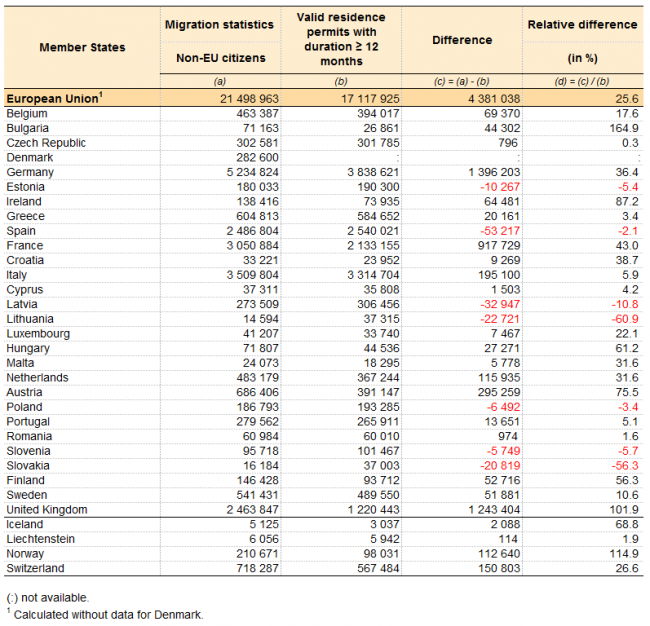
Table 5: Third-country nationals in the usually resident population at the end of 2016 as derived from statistics on migration and residence permits
Source: Eurostat (migr_pop1ctz) and (migr_resvalid)
The flow data on immigration refer to the entire inflow of people taking up usual residence in the reporting country during the year of reference, while stock data on immigration refer to people having usual residence in the reporting country at the end of the year. If the statistical unit (individual person) is the same for collecting both sets of data, the concept used for identifying those people differs from the one used in residence permits: on the one hand (for immigration data), the concept of usual residence applies; on the other (for data on residence permits) the concept of authorisation to stay for at least 3 months applies.
Besides the issue related to the residence permit’s duration, which could be partially solved by using the reason for immigrating or by removing residence permits of less than 12 months duration from the data, an authorisation to stay in a country may not correspond to an actual stay. For example, a third-country national who has been granted a residence permit by a Member State may have never entered or left the country or a holder of a long-term residence permit may have left the country while still being recorded in the residence permits’ register.
To gain a better understanding of the reasons behind differences between residence permits and migration statistics, Eurostat has been carrying out a survey among Member States since October 2017 and is currently investigating how to quantify the impact of each identified reason. Table 6 below presents a list of the main reasons identified so far.
Moreover, as shown in Figure 4, the relative difference in percentage points varies greatly among Member States which indicates that reasons for the discrepancy should be significantly inherent to each considered Member State, depending on sources used, statistical practices and on the national regulations applied for issuing residence permits. It can also be pointed out that the discrepancy in relative terms is higher than 25 % in 13 Member States, but a negative discrepancy (when the figure for residence permits is higher than migrant stock) is only observed in Lithuania and Slovakia. This pattern tends to confirm that most of the observed discrepancy could be explained by an under-coverage of residence permits’ statistics.

Figure 4: Stock of migrants less number of valid residence permits (≥ 12 months) at the end of 2016
(relative difference in %)
Source: Eurostat (migr_pop1ctz) and (migr_resvalid)
Asylum statistics
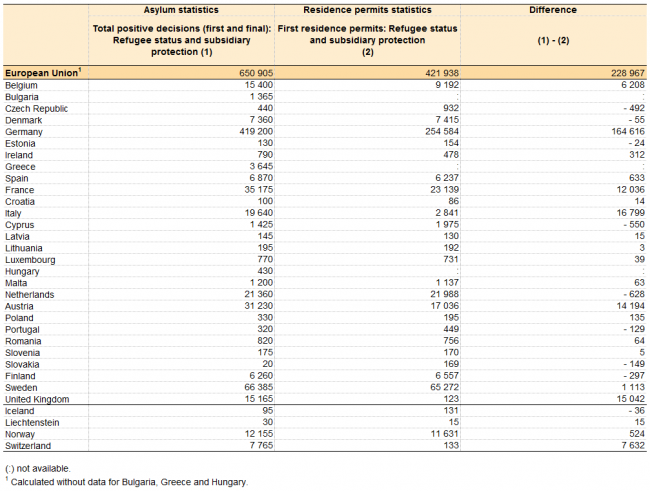
Table 7: Comparison between the number of total positive decisions on asylum applications and the number of first residence permits issued during the year 2016 for international protection reasons
Source: Eurostat (migr_asydcfsta), (migr_asydcfina) and (migr_resoth)
Data on residence permits are also related to asylum statistics since the statistics (flows and stocks) on residence permits issued for international protection reasons (refugee status and subsidiary protection) cover the same target population. In particular, asylum statistics on the number of positive decisions taken during the year can be compared with the total number of first residence permits issued during the year for international protection reasons.
As a positive decision concerning an asylum applicant gives the beneficiary the right to be granted a residence permit, comparison between the number of first residence permits issued during the year for international protection reasons and the number of positive decisions provides a good match. However, any delay between a positive decision on asylum application and the actual issue of a residence permit generates a discrepancy between both sets of statistics since the actual issuance of the residence permit may be recorded in a different year from that of the decision. Other reasons may also cause some discrepancies, such as the amount of time an asylum applicant actually stays after a decision; the correct recording of the number of people covered by a decision; and the use of different data sources used to produce statistics on asylum and on residence permits.
Statistics on residence permits also provide information on the total number of third-country nationals holding a valid residence permit for international protection reasons at the end of the year (refugee status and subsidiary protection). Theoretically, those statistics on stocks should reflect to a certain extent the flows recorded in asylum statistics on total positive decisions. At EU level, the total number of positive decisions amounted to 1.1 million from 2014 to 2016, whereas the stock of valid residence permits increased by about 0.6 million during the same period. This discrepancy can be partly explained by the lag time between a decision and the issue of an actual residence permit as well as by the number of refugees and beneficiaries of subsidiary protection leaving the country. However, it also seems likely that, depending on the national administrative systems, the beneficiaries of international protection could be difficult to identify in the statistics when their residence permits are renewed. This may imply some under-coverage of the statistics on the total number of third-country nationals holding a valid residence permit for international protection reasons at the end of the year.
Analytical framework
Available data on residence permits can be used for several types of analysis. Therefore, this section is dedicated to presenting some questions in which statistics on residence permits can provide some insights, also mentioning, when necessary, how those statistics are limited.
How many third-country nationals (non-EU citizens) have been granted an authorisation to stay in EU territory for the first time?
First residence permits issued during the year measure the number of third-country nationals authorised for the first time to stay in EU and EFTA countries. Therefore, this data provides an insight on the potential demand of non-EU citizens who want to reside in EU or EFTA countries. Even if statistics on first residence permits are not strictly comparable with immigration statistics in the EU, they can contain potential information on the trend and the distribution of various reasons to enter the EU.
How many third-country nationals are authorised to stay in EU territory?
Stock data on residence permits gives an answer to this question. When using this data, one must keep in mind that it deals with authorisations and not with actual residence and therefore cannot replace statistics on stock of migrants.
What are the main reasons for issuing a residence permit?
Since statistics on residence permits are broken down by reasons, data published by Eurostat provides the necessary information to undertake a detailed analysis of the main reasons for issuing a residence permit. The heterogeneity of the residual category ‘other reasons’ implies that it must be analysed very cautiously, taking into account all available methodological information on the content of this category in each Member State. For each of the four main categories (family, education, work and other), supplementary breakdown is also available which enables a more refined analysis. Other available breakdowns (citizenship, age, duration and sex) may also be used for identifying some more specific patterns. Since data are available for flows and stocks, analysis comparing recent development with the structure can also provide useful information for detecting structural changes.
What is the citizenship of the third-country nationals who hold a residence permit?
Both flow and stock data are broken down by citizenship of third-country nationals. Those statistics show the main citizenships represented among the third-country nationals who have been granted a residence permit. Crossing citizenship data with other available breakdowns like the breakdown by reasons allows analysis to be refined. As for other variables of interest, the availability of flow and stock data enables the analysing of trends and structures, as well as the detecting of potential structural changes.
For how long are the residence permits issued to third-country nationals valid?
Statistics on residence permits are broken down by duration, which gives information on how long residence permit holders are authorised to stay (between 3 and 5 months, between 6 and 11 months or at least 12 months). For ICT and seasonal workers, the number of permits valid for less than 3 months is also available. Crossing this data with other available breakdowns (age, reasons, sex and citizenship) can bring useful information on the characteristics of short-term and long-term immigration. Available data on long-term permits, such as the share of long-term permits in the total number of residence permits, provides extra information on the integration of third-country nationals.
What is the structure by age and by sex of the holders of a residence permit?
Analysing the available statistics on the structure by age and sex of third-country nationals holding a residence permit provides useful information in, for example, estimating the possible impact on the demography and the labour market of receiving Member States. Data on residence permits is not directly comparable with data on international migration, which can require the analysis to be complemented with available data on immigration.
How many third-country national students are authorised to study in the EU?
Both stock and flow statistics on the number of residence permits granted to third-country nationals for education reasons allow the inflow of third-country nationals students to be measured. Availability of flows and stocks enables both trends and structures to be analysed, while available breakdown by citizenship provides information on the origin of third-country nationals staying in a Member State for education reasons. Additional information on student mobility is also available in the education statistics published by Eurostat[9].
What is the nature of third-country nationals and what is their potential as workers?
Several types of data can be used for answering this question. In order to know the potential labour force, statistics on residence permits concerning third-country nationals aged between 16 and 74 can provide a first estimate. This information can be complemented by the number of residence permits issued for remunerated activities reasons. Breakdowns by duration and citizenship as well as using the detailed breakdown by reasons (highly skilled workers, EU Blue Cards, researchers, seasonal workers, other remunerated activities) provide extra information on the main characteristics related to the issuing of residence permits for remunerated activities reasons. Furthermore, statistics on single permits give an estimate of the minimum number of third-country nationals who have been given the right to work each year. For a more complete picture on the integration of third-country nationals into the EU labour market, analysing data from the Labour Force Survey is recommended.
How many highly qualified third-country nationals are authorised to work in the EU?
Statistics on residence permits concerning highly qualified employment and EU Blue Cards can be used for analysing the inflow of this specific category of third-country nationals. Inflow breakdowns by citizenship, occupation, age and sex may give additional information if required. The ratio between the number of EU Blue Cards and the total number of highly qualified workers (highly qualified employment plus EU Blue Cards) can also be used for measuring the development of the EU Blue Cards’ scheme.
To what extent are EU directives in the field of asylum and managed migration implemented to simplify the procedures for entering and staying in the EU and to guarantee beneficiaries a common set of rights?
Statistics on single permits show the extent to which this simplified procedure is applied within the EU and how many third-country nationals benefit from a common set of rights, including the right to work.
How many third-country nationals are authorised to work as seasonal workers or ICT workers?
New statistics collected by Eurostat from 2018 onwards are focusing on two specific aspects of the EU labour market: seasonal work and ICT. Therefore, it will become possible to analyse the development in these two areas which will enable assessments on how the EU directives are applied. As a conclusion, the area concerning statistics on residence permits is still constantly evolving depending, in particular, on the development of EU asylum and managed migration policy and on the users’ needs. Therefore, the main areas for development in providing statistics on residence permits consist of the following:
- possibly develop new data collections in order to provide data on more specific types of migration (self-employed, investors, researchers and students) when necessary;
- increase the analytical power of statistics on residence permits either by collecting new variables or crossing data with other related areas (employment statistics, education statistics, international migration statistics or health statistics);
- improve the comparability and harmonisation of statistics on residence permits; and
- provide the users of statistics on residence permits with all the necessary methodological definitions and concepts in an accessible way.
Source data for tables and graphs
Footnotes
- Persons not having an EU citizenship. ↑
- http://ec.europa.eu/eurostat/web/asylum-and-managed-migration/overview ↑
- Since the United Kingdom does not operate a system of residence permits, statistics for the United Kingdom are estimated based upon the numbers of arrivals of non-EU citizens permitted to enter the country under selected immigration categories. ↑
- Availability of flow data depends on the type of residence permit considered. ↑
- See also p. 34 of the technical guidelines on statistics on residence permits http://ec.europa.eu/eurostat/cache/metadata/Annexes/migr_res_esms_an8.pdf ↑
- See article 3 of the EU Single Permit Directive https://eur-lex.europa.eu/legal-content/EN/TXT/PDF/?uri=CELEX:32011L0098&from=EN ↑
- http://ec.europa.eu/eurostat/cache/metadata/Annexes/migr_res_esms_an2.pdf ↑
- http://ec.europa.eu/eurostat/web/population-demography-migration-projections/migration-and-citizenship-data ↑
- http://ec.europa.eu/eurostat/web/education-and-training/overview ↑

